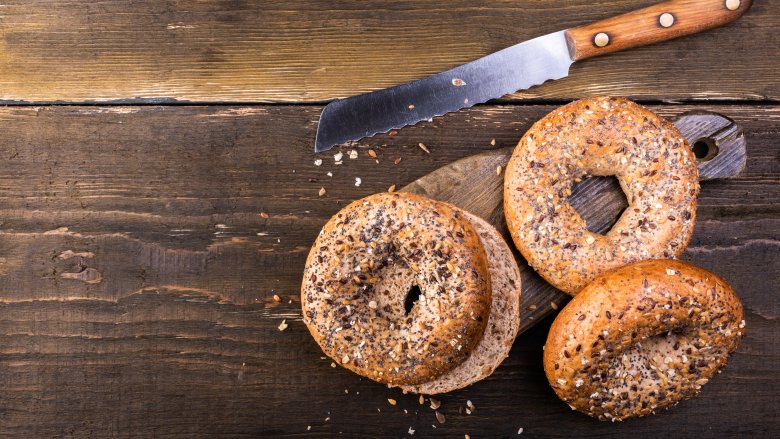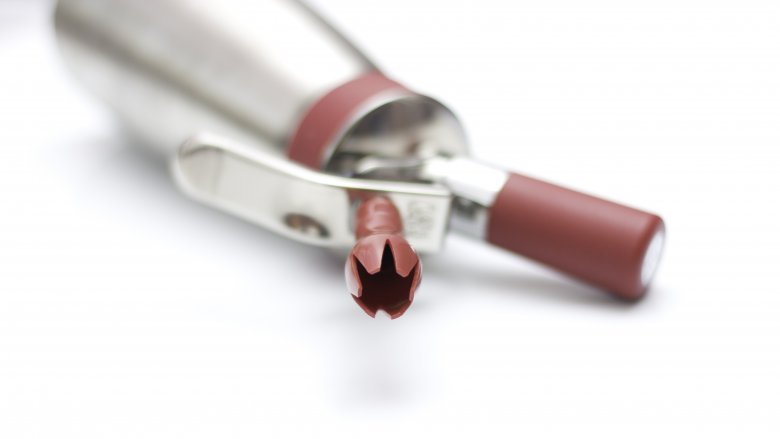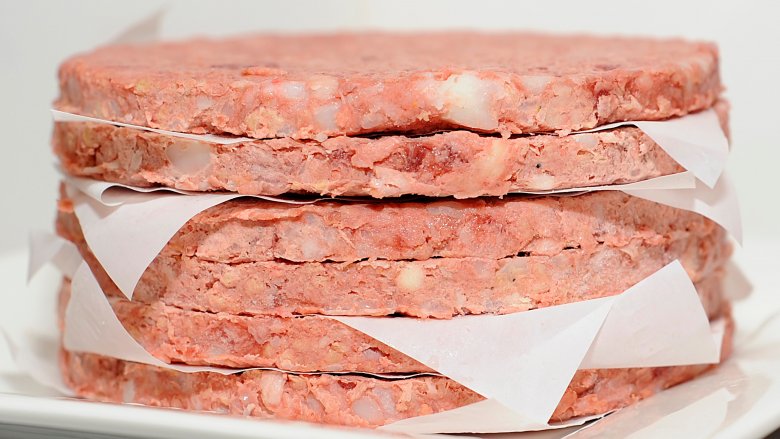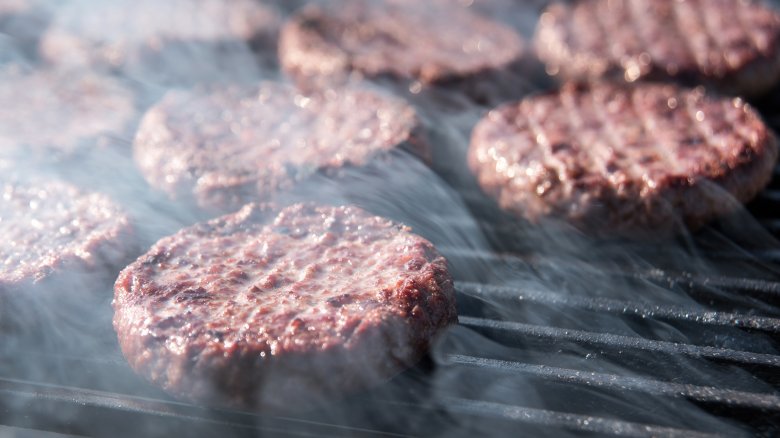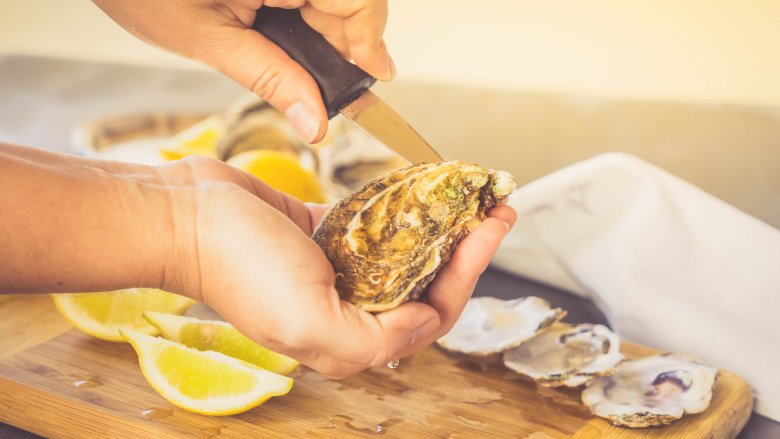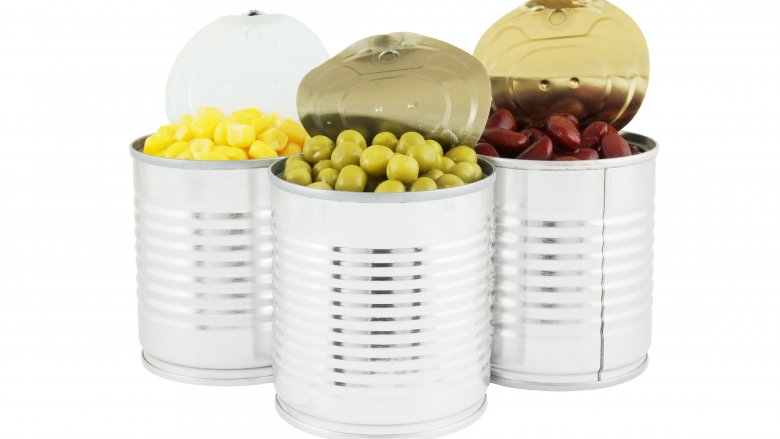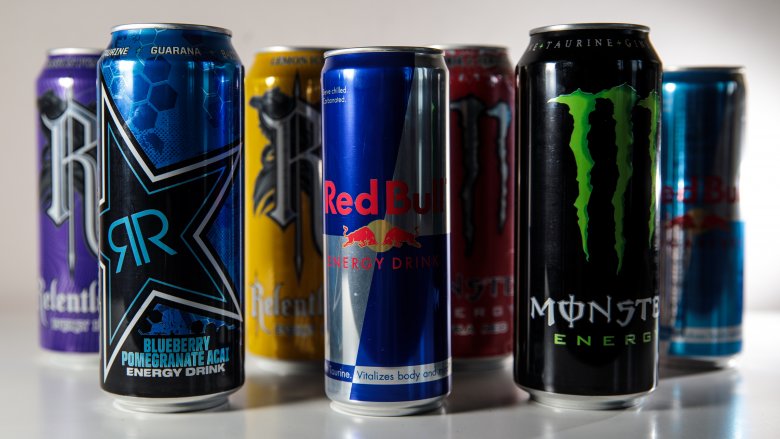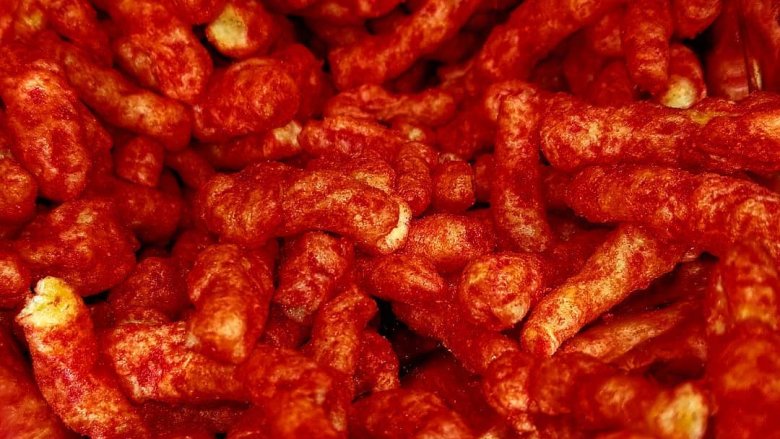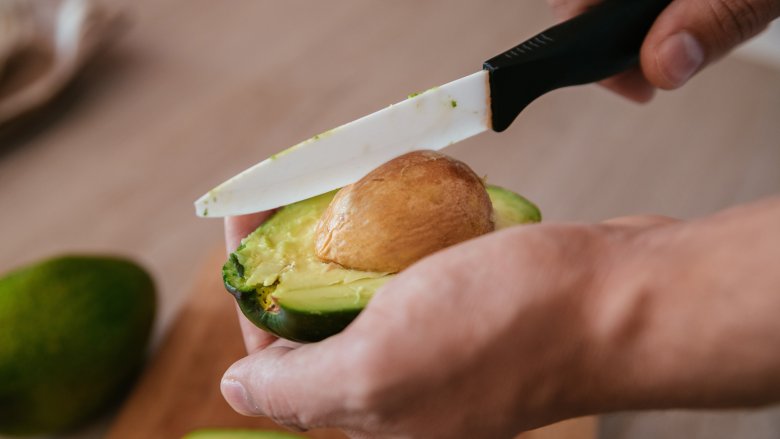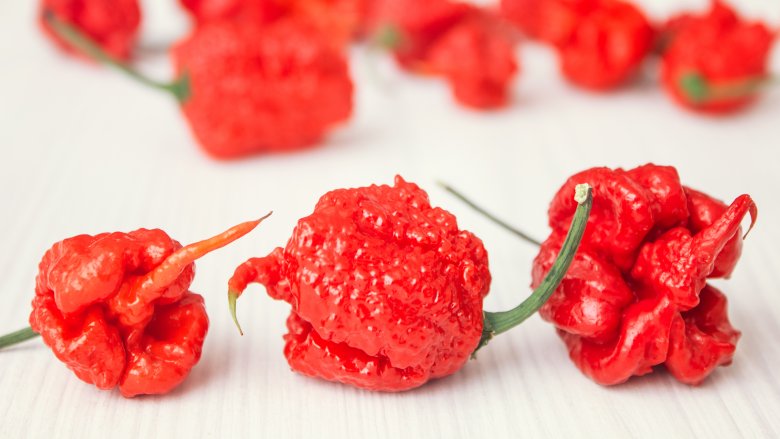The Surprising Reason These Foods Send People To The Emergency Room
We may receive a commission on purchases made from links.
There are certain dangers inherent to cooking that we're all aware of — the usual nicks from careless knife work, the minor burns from hot pans and spattering oil, and the inevitable shaving of the knuckles when using a mandolin. While none of these are especially pleasant to endure, they aren't typically injuries that will land you in the emergency room. But surprisingly, there are plenty of seemingly innocuous foods and food preparation techniques that will land you in the emergency room. And it turns out that some of our favorite meals are some of the most dangerous.
Like to grill? Both frozen hamburger patties and cooked hamburger patties can cause injury for very different reasons. What about pizza? Even if you're not making it yourself there are numerous ways it can hurt you, and no, it's not just the usual roof-of-the-mouth burn.
And those aren't the only things you need to worry about — from bagels to canned goods to cinnamon, here are the surprising reasons these foods could send you to the ER.
Bagels
Alton Brown is famously against unitaskers — the typically ridiculous, one-use kitchen gadgets that only serve to clutter the cabinets and take up counter space. But if you're interested in not slicing your fingers off, the bagel guillotine just might be one unitasker worth buying.
According to New Yorker Bagels, everyone's favorite breakfast food is responsible for sending plenty of people to the emergency room for serious cuts to the hands and fingers. About half of those injuries occur when trying to slice a frozen bagel, which can slip under the pressure of the knife and send the blade into your flesh instead. The other half of injuries occur when trying to slice a bagel with a non-serrated knife, which, potential injury aside, is only going to squish your breakfast into oblivion.
So how do you get your fix without buying a unitasker or ending up in the ER? Take this pro tip from Bagel Boyz, who tweeted, "To safely slice a #bagel without a bagel slicer, place the bagel flat on a table with your hand on top. Use a serrated knife to slice halfway through, keeping the blade horizontal to the table. Then stand the bagel on its end and finish slicing downward."
Whipped cream
Say it isn't so! The heavenly dairy topping we liberally add to our coffee drinks, ice cream sundaes, and, if we're being honest, spray directly into our mouths, couldn't possibly be responsible for causing bodily harm to people, could it? Well, yes and no.
It's not the actual whipped cream you have to worry about (thankfully), it's the pressurized canister that dispenses it. But don't go throwing away your grocery store spray cans just yet — the disposable containers aren't the problem. It's the professional grade reusable canisters you have to worry about — think barista quality — because of their potential to explode.
In June 2017, Rebecca Burger, a French fitness model, died when the canister she was using exploded and hit her in the chest, which lead to cardiac arrest. Though she is thought to be the first person to die from the defective product, she definitely wasn't the first to sustain injuries. The Daily News reports that since 2010, five dozen injuries have occurred due to exploding devices including broken ribs, broken teeth, tinnitus, and the loss of an eye. Shortly following reports of Burger's death, another women was injured when the canister she was using exploded and hit her in the leg. "I shake the bottle, and — boom — it explodes," she said. "It was terrible, the lid was gone and the bottle was lodged in the ceiling. If I had taken that to the head, I would have been finished."
Frozen burger patties
So you bought a stack of premade frozen burger patties for your cookout, but now the grill is ready and you realize that the wax paper separating those patties has done nothing to actually keep them apart. What do you do? Against your better judgement, you probably grab a knife and proceed to jam it forcefully between the frozen patties. We all know where this is headed... rather than separating the patties, you end up stabbing yourself in the hand instead, because of course you used the sharpest knife you could find, and of course it slipped from the frozen meat.
In 2011, San Francisco Giants pitcher Jeremy Affeldt ended his season doing just that. "It was a paring knife. He was trying to separate some frozen burgers and it slipped. It went pretty deep in his hand. It went to the bone. He lost feeling in his pinkie," manager Bruce Bochy said. Affeldt required surgery to repair the damage, and probably spent the rest of the season wishing he had grabbed a butter knife instead. Or, you know, had exhibited a little patience.
Cooked burger patties
Now that you've successfully separated the frozen hamburger patties without stabbing yourself, you can let your guard down, right? Not so fast — it turns out that cooked burgers have the potential to injure you, too, and this time, it has nothing to do with negligence or impatience.
Before you throw your burgers on the grill, do you do the right thing and clean the grates with your trusty wire brush? If so, doing the right thing is exactly what can get you into trouble in this case. Those wire bristles can detach from the brush and stick to the grates, and when your patty hits the grill, the bristles can adhere to the meat. Next stop: your mouth, throat, and in the worst cases, your stomach and intestines. According to a study published in 2016, an estimated 1698 emergency room visits occurred between 2002 to 2014 due to wire bristles in grilled food, most commonly due to oral cavity injury.
Is anyone else crossing hamburgers off their cookout list?
Oysters
We've all heard the gnarly stories about the after-effects of eating a bad oyster, and the likely cause of that is vibriosis, an infection caused by bacteria present in raw oysters and other shellfish. According to the CDC, about 80,000 people get vibriosis in the United States every year. In most cases though, you might spend a little extra time in the bathroom, but not the emergency room.
Opening raw oysters is another matter. As easy as the pros make it look, you know if you've ever attempted to pry one open that it's no simple feat, and according to Oysters.us, unsuccessful attempts lead to thousands of people seeking medical attention each year. Using a sharp kitchen knife is a surefire way to stab yourself in the hand or the forearm, because oysters can unexpectedly release and send that blade directly into your flesh. Another danger in opening oysters are cuts from the shells themselves. The craggy outsides of oysters can be as sharp as razor blades, and before you know it your hand is gushing blood before you've even picked up a knife.
An oyster knife and gloves are good safeguards, or maybe just hit the raw bar and avoid the possible ER visit altogether?
Canned foods
In this day and age, with all the fancy electric can openers and gadgets out there, you'd think opening a can of beans would be a breeze. But sometimes those lids prove to be so stubborn you just want to throw the whole can out the window. And based on these findings by Nottingham University, you're not the only one struggling.
Researchers investigated the potential dangers of badly designed packaging, and the results were harrowing when it came to canned foods. According to the study "more than 60,000 people require hospital treatment each year after injuring themselves opening difficult packaging." Of those, almost 9000 people (13.8 percent) cut themselves while opening cans of corned beef, while other canned foods were responsible for 17,671 (26 percent) injuries requiring hospital treatment. Shockingly, researchers even found instances of people who had cut off their fingers completely in an attempt to cut a can in half with a knife. Now that's one stubborn can of corned beef.
Pizza
Pizza just might be one of the the world's most perfect foods, but it turns out that even perfect food can betray you (and subsequently land you in the emergency room).
The US Consumer Product Safety Commission caused quite a stir in September 2018 when they tweeted this bombshell: "2300 ER visits associated with pizza in 2017. Injuries included, but were not limited to: cuts (from cutting pizza), burns (from pizza and pans), falling while carrying pizza, falling in pizza places, falling out of bed while reaching for pizza." Okay... cuts and burns we can understand. And falling while carrying pizza is also understandable — you're distracted by that hot cheesy pie you're about to eat. But falling out of bed while reaching for pizza? Maybe it's time to examine your life choices.
Aside from those injuries listed by the CPSC, you've also got to keep an eye out for bones hiding in your pizza. In 2010, one Round Table customer swallowed a chicken bone, which ultimately pierced her esophagus in two places. The injury required an astounding 11 surgeries to repair the damage.
Energy drinks
Energy drinks might seem like a quick and easy way to give yourself a little boost, but there is such a thing as too much of a good thing...
According to a report by the Substance Abuse and Mental Health Services Administration, emergency room visits related to caffeinated energy drinks doubled from 2007 to 2011, skyrocketing from 10,068 visits to 20,783 visits, respectively. And it's not just those who double down on the jolt by combining it with drugs or alcohol — 60 percent of those seeking medical attention had consumed the drink by itself and experienced adverse reactions like muscle tremors, seizures, and rapid heartbeat. Those who combined the energy drink with alcohol made up 13 percent of patients, while 27 percent had combined it with prescription drugs.
In 2016, a McDonald's latte, a large Mountain Dew, and a 16-ounce energy drink proved to be a lethal combination for one 16-year-old in South Carolina, who collapsed after consuming the staggering amount of caffeine in the span of two hours. Ultimately, "caffeine-induced cardiac event causing a probable arrhythmia" was listed as the cause of his death.
Flamin' Hot Cheetos
Is there anything worse than the neon red-orange fingers that result in inhaling a bag of Flamin' Hot Cheetos? Yep, there is, and this particular ailment associated with the spicy snack could land you in the emergency room.
In recent years, doctors have seen an uptick in both kids and adults seeking medical attention due to gastritis, or the inflammation of the stomach lining, a condition that can be caused by the spicy Cheetos. One 12-year-old who ate a shocking 20-30 bags of the snack per month ended up in the ER after complaining about stomach pain for weeks. It feels "like if you have a bruise or something. It really hurts a lot," he told ABC News.
But what is it about Flamin' Hot Cheetos and other similar spicy chips that causes gastritis? Dr. Robert Glatter says he doesn't think it has to do with the spiciness so much as the ingredients used in the coating of these snacks, "causing the stomach pH to change." "In the past, I had not seen any problems with snack food until spicy flavoring became more popular," he said. In other words, hot salsa probably won't send you to the emergency room, but a snack with a massive ingredients list in the coating alone, just might. Shocker?
Avocados
Everyone's favorite toast topper is among the long list of foods that will probably send us to the emergency room for a serious hand injury. Yes, "avocado hand" is a real thing, and it occurs when we mishandle the fruit.
Think about it: When you're cutting open an avocado, do you keep it on the cutting board, or do you stab at it with a sharp knife while you hold it in the palm of your hand? We all know the answer to that one. Then, once it's cut in half, you probably whack at the pit with the knife, also while holding the avocado in your hand. And lastly, you probably slice the fruit into sections down to the peel — you guessed it — while holding it in your hand. All of these actions can result in cuts and stab wounds to the hand, or worst case, do enough damage to your nerves and tendons that surgery is required.
Basically, every time you eat an avocado-topped bagel and don't land in the ER, you should consider yourself lucky.
Cinnamon
Too much apple pie might give you a stomachache, but you certainly can't blame its cinnamon content. No, in its typical use, cinnamon likely won't prompt you to seek medical attention, but if you try to swallow a tablespoon of the spice without a drop of water, there's a much greater chance you're heading to the ER.
But who in their right mind would swallow a tablespoon of cinnamon? Those seeking viral fame by attempting ridiculous — and often dangerous — internet "challenges," that's who.
An ER doctor writing for Forbes confirmed in 2013 that the "cinnamon challenge" led to an upsurge in both calls to poison centers and hospital visits, with patients experiencing serious complications like "choking, respiratory failure, and collapsed lungs, along with possible development of so called 'reactive airways' or wheezing after exposure to the cinnamon powder." Dr. Glatter also warns that even if you seem to make it out of the challenge unscathed, there's still a good chance of developing a chronic cough.
Sounds like a good trade-off for your 15 minutes of internet fame, doesn't it?
Hot chili peppers
So you've sworn off Flamin' Hot Cheetos due to the gastritis potential, but you're still chowing down on hot chili peppers without a care in the world. What could go wrong? If you're really unlucky, a lot...
Take the unfortunate eating contest participant who ate a burger topped with ghost pepper puree — whose Scoville rating comes in at a jaw-dropping 1 million heat units — and then vomited so profusely that he tore a hole in his esophagus. The condition, known as Boerhaave syndrome, is rare but has a high mortality rate, and required life-saving emergency surgery and a 23-day stay in the hospital.
Another insanely hot pepper, the Carolina Reaper, is responsible for sending a man to the ER after experiencing "intense neck pain and headaches that would last only a few seconds but that continued over the next several days." The condition, known as "thunderclap headaches," is thought to have been brought on from the consumption of the super spicy pepper, and is caused by reversible cerebral vasoconstriction syndrome, or in layman's terms, "temporarily constricted arteries in the brain."
Apparently we can cross all the hot peppers of our lists of things to eat, along with avocados, burgers, and maybe worst of all, pizza.

